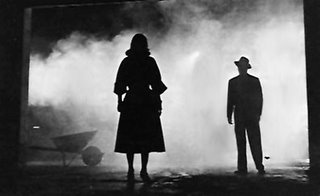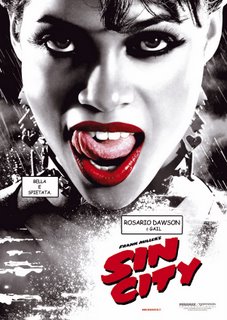
“Sin City” (2005, Hollywood production, directed by Frank Miller, Robert Rodriguez, and a single scene by Quentin Tarantino) posses several voiceovers provided by three main characters. But by extension, this is the only way we hear them. Outside of a sentence or perhaps per twelve scenes, they don't speak.
This is an obvious convention of film noire. One utilized so as to have the audience better identify with the protagonist's perspectives, as well as to give us a particular insight into their emotions and motives. And these mindset's–all stereotypically male–are environed in ripping their opposition a new rear-end.
These constant commentaries can become boring, as they all adhere in a particular preference of a patriarchal society. Hence the heroes’ be

lieves that they need to be the driving narrative force. Something which is bound to annoy some feminists, especially when they quickly realize that there isn’t any female voiceover – another convention of film noire. Which is my point; to all the varyingly violent voices, there isn't any prominent “voice of reason” which would help to create a particularly striking contrast, and the lack of a feminine perceptive suggests that the film noire genre hasn’t developed much from its earlier experiments. That, however, is not to hint that there isn’t anything particularly striking or contrasting in the mise-en-scene.
There is a crisp, sheen of ebony and ivory that is smoothed throughout ever scene of the entire movie, via editing. While “Sky Captain and the World of Tomorrow” (2004, Hollywood production, directed by Kerry Conran) was the first film to have utilized this absence of vibrant colour, it is another convention of “black film,” and it's also done for a more intricate result: homage paid in two shades of awesome.
The first is a tribute to the style in which Frank Miller’s acclaimed graphic comics were drawn, the same which this film was adapted from. This is a reverence which should strike such a familiar feel that any of his inherited audience will be nostalgic from the old atmosphere, yet excited by the new.
The final type of homage is to past film-noire movies. They purposely used the lack of Technicolor technology to enhance a gritty atmosphere that is somewhat the essence of these types of film. This is perhaps just one of several reasons behind Frank Miller and Robert Rodriguez consciously deciding to do the text in its unique fashion. Especially as they wouldn’t be lacking of funds or media means like those of the past–theirs is a blockbuster with a big budget. Instead, it is done to help highlight the characters.
All the characters have only one outspoken colour on their person, which ranges from their eyes, too their clothing, or just an accessory.
These highlighted item or genetic feature for each character helps us to define their personality. The colours are arranged for simple denotations, blue bleats for cowardice. Red roars for passion, blood, and malice. And yellow for a miasmic aura of rotten, disgusting and spoilt. This gives Sin City an outstandingly vivacious flair that any would be folly to deny. Unfortunately, a lot in this movie is hard to misread, or more accurately, attach many alternative interpretations to. So it may downbeat on those of us whom want to use this text for the analyse section; everything is somewhat obvious in the stagnant Hollywood way of thinking. Except for the narrative structure and plot.
The three different–but interlinked–storylines are neatly woven together. And fans of the comic book will be thrilled to realise that they are based on “The Hard Goodbye”, “The Big Fat Kill”, and “That Yellow Bastard.” Thankfully, those like myself that didn’t know a damn thing about them won’t be left to the beatings, the rapes or the murders of Sin City. Instead, we’ll have Hartigan (Bruce Willis), Dwight (Clive Owen), Gail (Rosario Dawson), Marv (Mickey Rourke) and deadly lil Miho (Devon Aoki) take ‘em for us. All while we’re being pulled fully up to a fast-paced, action-based understanding of how the Old Town femme fatales ensure their own brand of injustice stays intact. And that to maintain that injustice is the only way for our protagonists to escape it themselves. Everything from the acting to the edited slides together beautifully. After dodging the dregs of Sin City, after following these intriguing anti-heroes, it’s impossible for you not to think that, “turn the right corner in Sin City and you can find – anything.”





